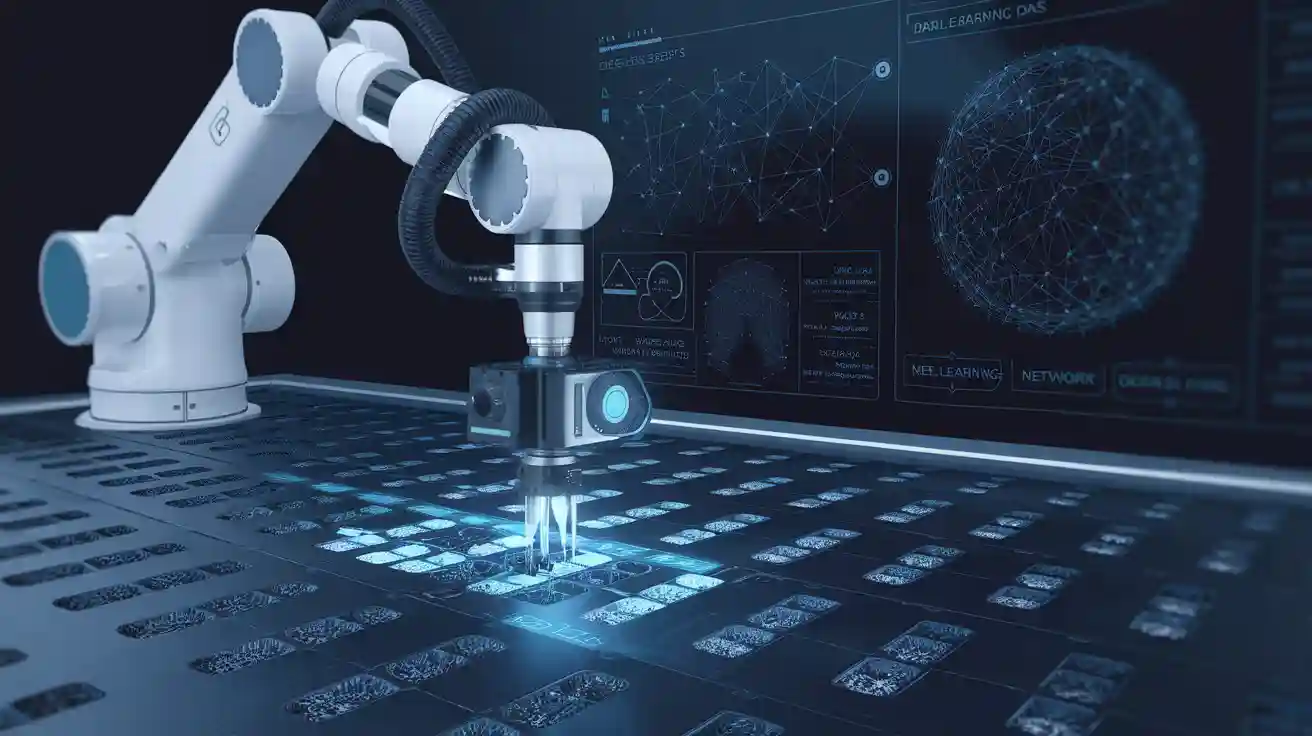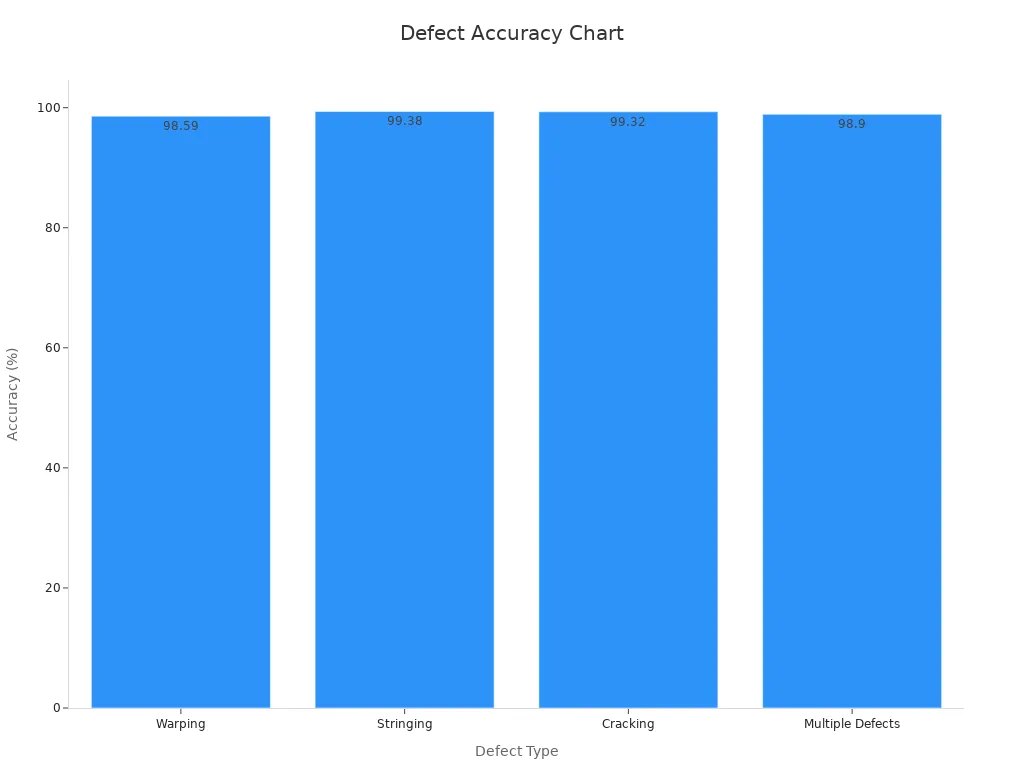Unlocking Defect Detection with Deep Learning Power

Deep learning has revolutionized defect detection in machine vision systems by delivering unmatched accuracy and efficiency. For example, deep transfer learning achieves a 96% classification accuracy in X-ray inspections of aeronautic materials. Over the past decade, the transition from manual inspections to AI-powered tools has marked a significant leap in defect detection. Deep learning models now detect 98% of defects, surpassing traditional methods. These systems also ensure consistent performance, adapt quickly to new challenges, and enable real-time inspections. With the Deep Learning for Defect Detection machine vision system, you can identify even the most subtle imperfections effortlessly.
Key Takeaways
- Deep learning models can find defects with 98% accuracy. This is much better than older methods.
- Setting up deep learning needs steps like gathering data, picking a model, and testing it live to make sure it works well.
- AI-powered systems check products 40% faster, helping inspect thousands quickly.
- Deep learning lowers defect rates from 5% to less than 2%. This saves money and makes customers happier.
- Solve problems like not enough data or bad-quality inputs by collecting better data and using smarter networks.
Defect Detection in AI-Driven Machine Vision Systems
Importance of Defect Detection
Defect detection plays a vital role in ensuring the quality of products and processes. You rely on it to identify anomalies that could compromise safety, performance, or customer satisfaction. In industrial applications, accurate detection prevents defective items from reaching consumers, saving costs and protecting brand reputation. Metrics like AUC, TPR, and Recall illustrate how well defect detection systems perform.
| Metric | Description |
|---|---|
| AUC | Measures the model’s ability to distinguish between defective and non-defective images. Higher values indicate better discrimination. |
| TPR | Percentage of correctly classified defective images. A value of 1 indicates all defects are detected. |
| FPR | Proportion of non-defective images incorrectly classified as defective. Lower values are preferred. |
| Recall | Ensures that all defective items are identified, critical for quality control. |
| F1 Score | Balances precision and recall, minimizing false positives while ensuring defect detection. |
These metrics highlight the importance of defect detection technology in maintaining high standards during quality inspection. By leveraging AI, you can achieve superior accuracy and efficiency in anomaly detection, ensuring consistent results across machine vision systems.
Traditional Methods vs. Deep Learning
Traditional defect detection methods rely on rule-based algorithms or manual inspections. These approaches often struggle with complex patterns or subtle anomalies. For example, manual inspection depends on human judgment, which can vary and lead to inconsistent results. Rule-based systems require predefined criteria, making them less adaptable to new challenges.
Deep learning transforms this process by using AI to analyze data and learn patterns autonomously. Unlike traditional methods, deep learning models excel at anomaly detection in diverse scenarios. Metrics such as AUC, Precision, and Recall demonstrate their superiority.
| Metric | Description |
|---|---|
| AUC | Measures the model’s ability to distinguish between defective and non-defective images. |
| Precision | Indicates the quality of positive predictions. |
| Recall | Reflects the model's ability to find all relevant cases. |
| F1 Score | Balances precision and recall for overall performance evaluation. |
Deep learning enhances quality inspection by detecting defects with greater accuracy and speed. It adapts to new data, making it ideal for dynamic environments. With AI-driven machine vision systems, you can achieve reliable and scalable defect detection, ensuring high-quality standards in every inspection.
Deep Learning for Defect Detection Machine Vision System
Key Components of Deep Learning Models
Deep learning models form the backbone of defect detection in machine vision systems. These models rely on neural networks to process and analyze images, identifying defects with remarkable precision. Several key components contribute to their performance:
- Convolutional Layers: These layers extract features from images by applying filters. They help detect patterns like edges, textures, or shapes, which are crucial for identifying defects.
- Pooling Layers: Pooling reduces the spatial dimensions of feature maps, making computations faster and more efficient. It also helps the model focus on the most important features.
- Fully Connected Layers: These layers combine extracted features to make predictions. They play a vital role in classifying images as defective or non-defective.
- Activation Functions: Functions like ReLU or Sigmoid introduce non-linearity, enabling the model to learn complex patterns.
- Loss Functions: These functions measure the difference between predicted and actual outcomes, guiding the model during training to improve accuracy.
Recent experiments highlight the impact of these components on defect detection accuracy. For example:
| Model | Defect Type | Accuracy (%) |
|---|---|---|
| DenseNet121 | Warping | 98.59 |
| MobileNetV2 | Stringing | 99.38 |
| XceptionNet | Cracking | 99.32 |
| MobileNetV2 | Multiple Defects | 98.90 |
These results demonstrate how different neural networks excel in detecting specific defect types. By leveraging these components, you can build a robust deep learning for defect detection machine vision system.

Implementation Steps for Deep Learning in Defect Detection
Implementing a deep learning for defect detection machine vision system involves several steps. Each step ensures the model performs effectively in identifying defects:
- Data Collection and Preprocessing: Gather a diverse dataset of defective and non-defective images. Use image processing algorithms to enhance image quality and normalize data for consistency.
- Model Selection: Choose a neural network architecture suited to your application. For instance, MobileNetV2 works well for lightweight applications, while DenseNet121 excels in complex scenarios.
- Training the Model: Train the model using labeled data. During training, the model learns to recognize patterns associated with defects. Use metrics like accuracy and F1-score to evaluate performance.
- Validation and Testing: Validate the model on unseen data to ensure it generalizes well. Test it under real-world conditions to identify potential weaknesses.
- Optimization: Fine-tune hyperparameters, such as learning rate or batch size, to improve performance. Techniques like transfer learning can also enhance accuracy.
- Deployment: Integrate the trained model into your machine vision system. Ensure it operates efficiently in real-time environments.
Sequential experimental results validate these steps. For example:
| Model | mAP (IoU=0.5) | mAP (IoU=0.5:0.95) | Performance Notes |
|---|---|---|---|
| Proposed Model | 98.1% | Higher than others | Outperforms YOLOv5m by 3.2% in overall mAP |
| YOLOv5m | N/A | N/A | State-of-the-art model for comparison |
| YOLOv5s | N/A | N/A | Smaller model, lower performance than YOLOv5m |
| RetinaNet | N/A | N/A | Performance lower than YOLOv5 models |
| YOLOv3 | N/A | N/A | Performance lower than YOLOv5 models |
Data trends confirm that advanced implementation steps lead to gradual improvements in defect detection accuracy. For instance:
- The improved YOLOv5n model shows a 4.3% increase in mAP@50 compared to the original model.
- Detection accuracy improvements were noted across various defect categories, with Crazing and Inclusion showing the most significant enhancements.
By following these steps, you can create a powerful deep learning for defect detection machine vision system that delivers exceptional results.
Applications of Deep Learning in Defect Detection

Industry Use Cases
Deep learning has transformed defect detection across various industries, enabling you to achieve unprecedented levels of accuracy and efficiency. In manufacturing, AI-driven machine vision systems inspect products on high-speed production lines, identifying defects in real time. For example, automotive manufacturers use these systems to detect surface scratches, dents, or paint inconsistencies on car bodies. Similarly, in electronics, deep learning models analyze circuit boards to locate soldering defects or missing components.
A well-trained deep learning model significantly reduces defective products reaching customers. This enhances customer satisfaction and lowers costs associated with returns or repairs. Evaluating the model ensures it meets your business requirements before deployment. It also helps identify areas for improvement, ensuring optimal performance.
The measurable outcomes from industry trials further highlight the effectiveness of deep learning in defect detection. For instance:
| Backbone Network | IoU | Precision | Recall |
|---|---|---|---|
| ResNet-50 | ... | ... | ... |
| ResNet-34 | ... | ... | ... |
| SqueezeNet | ... | ... | ... |
| MobileNetv3 | ... | ... | ... |
| ShuffleNetv2_x2 | ... | ... | ... |
| GhostNetv3 | ... | ... | ... |
These results demonstrate how different neural networks excel in specific applications, allowing you to choose the best model for your needs.
The benefits extend beyond manufacturing. In healthcare, AI-driven machine vision systems analyze medical images to detect abnormalities like tumors or fractures. These systems process thousands of images simultaneously, identifying subtle patterns that human eyes might miss. In agriculture, deep learning models monitor crops for signs of disease or pest infestations, enabling timely interventions.
Benefits of AI-Driven Machine Vision Systems
AI-driven machine vision systems offer numerous advantages over traditional inspection methods. They process data at near-instantaneous speeds, enabling you to inspect thousands of products in a fraction of the time it would take manually. This speed increases throughput, allowing you to meet production targets without compromising quality.
The systems also excel in scalability and adaptability. You can easily re-train them for new products or inspection criteria, making them ideal for dynamic environments. Unlike traditional methods, which rely on predefined rules, these systems continuously learn and improve from new data.
Statistical data underscores the benefits of AI-driven machine vision systems. For example:
| Metric | Improvement |
|---|---|
| Inspection Speed | 40% increase |
| Identification Accuracy | 99% |
| Traceability Improvement | 99% |
These improvements translate into tangible business outcomes. You can reduce defect rates from 5% to under 2%, cut per-unit inspection costs by at least 50%, and achieve payback on your investment within two years.
“The biggest benefit of using AI for inspection applications on assembly lines is the ability to significantly improve product quality, reduce costs, and enhance overall manufacturing efficiency, which can lead to increased customer satisfaction and business success.”
In addition to cost savings, AI-driven machine vision systems enhance product yield and overall efficiency. A report by IBM indicates that deep learning algorithms can cut the time needed for quality control by up to 80%. According to McKinsey, implementing deep learning in quality control can improve defect detection accuracy by as much as 90%.
By adopting AI-driven machine vision systems, you can ensure consistent quality, reduce operational costs, and stay competitive in an increasingly automated world.
Challenges in Deep Learning for Defect Detection
Common Obstacles
Deep learning has transformed defect detection, but it comes with its own set of challenges. One major obstacle is the scarcity of defect samples. Strict production controls and high data collection costs make it difficult to gather enough examples for training. Additionally, privacy concerns often limit access to valuable datasets.
Low-quality data is another issue. Noise in the data can reduce detection accuracy, making it harder for models to identify defects. Complex defects, such as those with irregular shapes or subtle patterns, require advanced feature extraction methods. Traditional approaches often fail to address these complexities effectively.
Processing multimodal data also poses a challenge. Different types of data, like images and sensor readings, require specialized techniques for integration. Achieving real-time detection adds another layer of difficulty. Efficient algorithms are necessary to maintain performance under tight time constraints.
Finally, interpretability and transparency remain critical concerns. In industries like healthcare and manufacturing, understanding how a model makes decisions is essential. However, many deep learning models lack this clarity, making it harder to trust their outputs.
| Challenge | Description |
|---|---|
| Sample Scarcity | Defect samples are scarce due to strict production controls, high costs of data collection, and privacy concerns. |
| Data Quality Issues | Low-quality data can introduce noise, affecting model performance and detection accuracy. |
| Identification of Complex Defects | Complex defects require advanced feature extraction and classification methods, as traditional methods often fail to identify them accurately. |
| Multimodal Data Processing | Different data types require specialized techniques for effective processing and integration to enhance detection performance. |
| Real-Time Online Detection | Achieving real-time detection requires efficient algorithms and optimization to maintain performance under time constraints. |
| Interpretability and Transparency | Enhancing model transparency and interpretability is crucial, especially in critical applications, but current models often lack this clarity. |
| Privacy and Security | Protecting data privacy and security is essential, necessitating secure storage and encryption methods to prevent malicious attacks. |
Solutions to Overcome Challenges
You can address these challenges with targeted strategies. Start by focusing on high-quality labeled data. Investing in better data collection methods ensures your models perform effectively. Collaborating with industry partners can also help you access larger datasets, reducing the impact of sample scarcity.
For complex defects, advanced neural network architectures like DenseNet or MobileNet can improve detection. These models excel at extracting intricate features, enhancing accuracy. Techniques like transfer learning allow you to leverage pre-trained models, saving time and resources.
To handle multimodal data, consider using specialized frameworks that integrate different data types seamlessly. For real-time detection, optimize your algorithms by tuning parameters like dropout rates or adjusting the number of layers. These adjustments can significantly improve performance.
Improving interpretability requires tools that explain model decisions. Techniques like Grad-CAM or SHAP provide insights into how your model identifies defects. This transparency builds trust, especially in critical applications.
Finally, prioritize data security. Use encryption and secure storage methods to protect sensitive information. APIs can help integrate deep learning models with legacy systems, ensuring smooth communication and scalability.
“By addressing these challenges, you can unlock the full potential of deep learning for defect detection, achieving higher efficiency and reliability in quality control.”
Deep learning has revolutionized defect detection by delivering unmatched speed, accuracy, and cost-effectiveness.
| Benefit | Description |
|---|---|
| Speed | Models analyze thousands of images per second, enabling real-time inspections. |
| Accuracy | AI ensures consistent precision, reducing errors common in manual inspections. |
| Cost-effectiveness | Early defect detection prevents costly recalls and optimizes production efficiency. |
Adopting AI-driven machine vision systems enhances product quality, reduces waste, and improves customer satisfaction. Industries like automotive, electronics, and pharmaceuticals increasingly rely on these systems. By 2026, the market value is projected to reach $5 billion, driven by advancements in AI and operational efficiency. You can leverage this technology to stay competitive and ensure rigorous quality control.
The future of defect detection lies in deep learning, offering unparalleled potential to transform industries and redefine quality assurance.
FAQ
What is the role of data in deep learning for defect detection?
Data serves as the foundation for training deep learning models. You need high-quality, labeled datasets to teach the model how to identify defects. The more diverse and accurate your data, the better your model performs in real-world scenarios.
How do deep learning models handle subtle defects?
Deep learning models use advanced neural networks to detect subtle patterns. Layers like convolutional layers extract fine details from images, enabling the model to identify even the smallest imperfections. This makes them highly effective for complex defect detection tasks.
Can deep learning systems adapt to new defect types?
Yes, deep learning systems can adapt by retraining with new data. You can update the model with images of new defect types, allowing it to learn and recognize them. This adaptability makes these systems ideal for dynamic environments.
Are deep learning systems cost-effective for small businesses?
Deep learning systems can be cost-effective over time. While the initial investment may seem high, they reduce inspection costs, improve product quality, and minimize waste. These benefits often lead to significant savings and a quick return on investment.
How do you ensure the accuracy of a deep learning model?
You ensure accuracy by using diverse training data, validating the model on unseen datasets, and fine-tuning hyperparameters. Regular testing in real-world conditions also helps identify weaknesses and improve performance. Metrics like precision and recall measure the model’s effectiveness.
See Also
Exploring Machine Vision Systems For Effective Defect Detection
Analyzing Flaw Detection Techniques In Machine Vision Systems
The Role Of Deep Learning In Advancing Machine Vision
Comparing Traditional And Generative AI For Defect Detection
Ensure Flaw Detection With Advanced Verification Vision Systems
